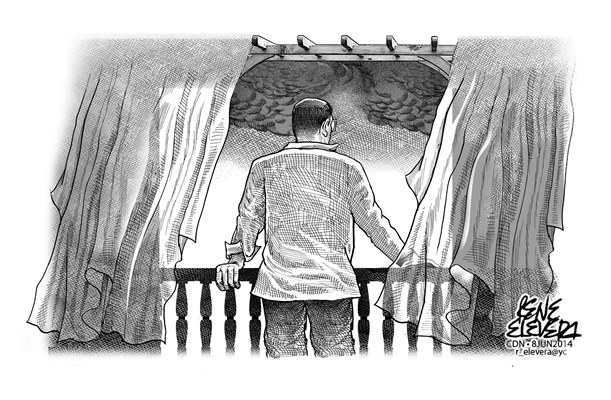I woke up to an overcast sky. I sat on the edge of the bed, facing an open balcony. A puddle on the pavement outside caught my eye.
We had nothing but blazing days the past several weeks and were praying for dark clouds to mitigate the insufferable heat. And here was proof of rain, although it came while we were sleeping. I smiled as I said my morning prayer.
Drops continued to fall on the film of ground water from a pergola above it, the residue of the rain foregathered and dripping from the tips of the leaves of the yellow bells. Every time a drop struck the puddle, it would leave a ripple, a widening ring.
I imagined the drops to be wisps of fire and the puddle the human mind, a scene much like that at Pentecost. In the Acts of the Apostles, we read this account: “When the day of Pentecost had come, they were all together in one place. And suddenly a sound came from heaven like the rush of a mighty wind, and it filled all the house where they were sitting. And there appeared to them tongues as of fire, distributed and resting on each one of them. And they were all filled with the Holy Spirit and began to speak in other tongues, as the Spirit gave them utterance.”
In Anthony Van Dyck’s painting, “The Descent of the Holy Spirit,” one hardly notices the tongues of fire. The Holy Spirit in the form of a dove hovers above the apostles and the Virgin Mary, sending out rays of light through the clouds.
It would seem that, in putting more emphasis on the dove than on the tongues of fire, Van Dyck wanted to put the focus on the provenance of the flames, and that it would not matter whether the manifestation of the Holy Spirit was in some other form.
In a vision, Hildegard of Bingen saw the “sprinkling drops of sweet rain” that John felt when he began writing his Gospel: “In the beginning was the Word…” Hildegard herself coined a word, viriditas, to describe “the greening power of God.” She declared, “There is a power that has been since all eternity and that force and potentiality is green!”
A poem she wrote elaborates on this:
“Oh fire of the Holy Spirit,
life of the life of every creature,
holy are you in giving life to forms…
Oh boldest path,
penetrating into all places,
in the heights, on earth,
and in every abyss,
you bring and bind all together
From you clouds flow, air flies,
Rocks have their humors,
Rivers spring forth from the waters
And earth wears her green vigor.”
I see the Holy Spirit wherever I notice growth, whether in the outer or in the inner world, and anything connected with energy and life, such as Hildegard enumerated in her poem: clouds, air, rocks, rivers, earth, and, of course, rain and fire.
Which was why I thought of the Holy Spirit when I saw the sporadic drops of rain cupped by the leaves, balling into light before falling. It added to the peace of the morning, and urged a prayer to grow within me.
The Eucharistic Prayer of the Mass describes the Holy Spirit as dewfall — “You are indeed Holy, O Lord, the fount of all holiness. Make holy, therefore, these gifts, we pray, by sending down your Spirit upon them like the dewfall, so that they may become for us the Body and Blood of our Lord Jesus Christ.”
Dew imperceptibly gathers on the ground, coming down to it and soaking it as though from within. In the Mass, the Holy Spirit falls on the bread and wine like the dew and turns them into the Body and Blood of Christ.
As I finished my prayer and rose from the edge of the bed, I noticed the sky reflected on the puddle. It was clear. The clouds had parted. The sun was out.
